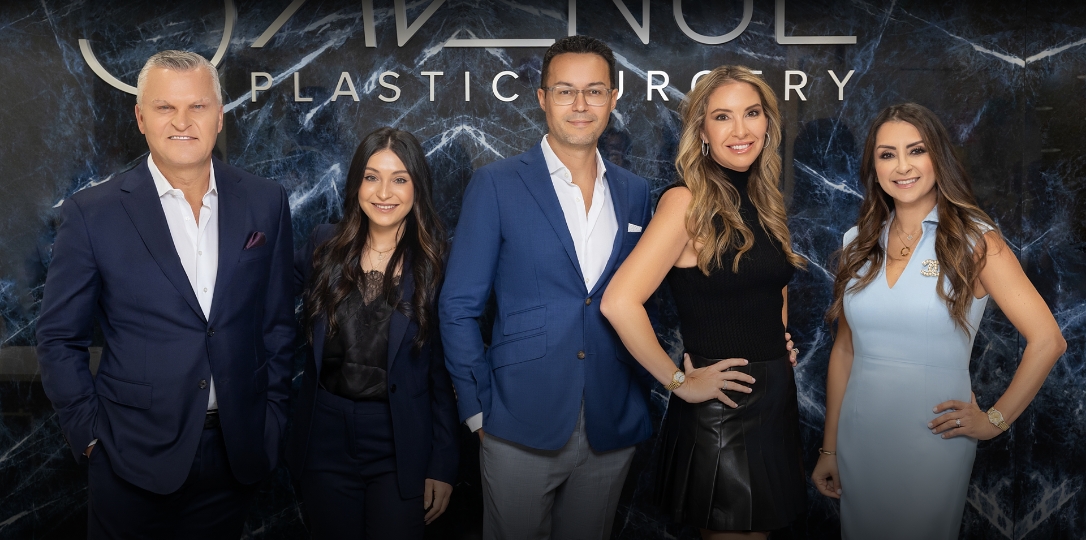Quick Links
Rejuvenate your facial balance with Rhinoplasty. A rhinoplasty alters the shape and size of your nose to create more balanced facial features. Our highly skilled surgeons perform Rhinoplasty, one of our most well-known nose procedures for reshaping, resizing, and altering the nose at 5th Avenue Plastic Surgery.
What is a Rhinoplasty?
Surgery of the nose, or Rhinoplasty, can accomplish various things. It can reduce the overall size of the nose, improve the tip, remove a bump, narrow or widen the width, improve the angle between the nose and the upper lip, or improve obstructions inside the nose that cause breathing problems. Rhinoplasty is one of the most common plastic surgery procedures performed today, but the experts in the field regard it to be the most difficult. The technical skill and experience of the surgeon and his complete understanding of the details of nasal anatomy, physiology, and facial aesthetics are imperative. The surgeon must also be able to predict the changes resulting from the alteration of each anatomic element of the nose. Rhinoplasty can also be performed with reconstructive nasal-septal surgery to relieve obstructions that may impair breathing.
QUICK FACTS
Recovery Time
2-3 Weeks
Anesthesia Type
IV Sedation or General Anesthesia
Rhinoplasty Candidates
A rhinoplasty is an ideal cosmetic treatment from a skilled facial plastic surgeon.
Our highly skilled double-board-certified Facial plastic surgeons utilize nose jobs in some of the following ways:
- Changing nose size about facial balance
- Altering nose width
- Decreasing visible humps or depressions on the bridge
- Altering an enlarged, drooping, upturned, or hooked nasal tip
- Fixing nostrils that are large, upturned, or wide
- Addressing nasal asymmetry
To be considered a good candidate, you should be in overall good health with no medical conditions that will affect your healing process. During a consultation, you’ll discuss your aesthetic goals for a nose job and determine whether Rhinoplasty suits you. Dr. Tzikas or Dr. Mascaró will provide an in-depth treatment plan based on your needs and concerns.
The Rhinoplasty Procedure
Your Rhinoplasty will begin with your double-board-certified facial plastic surgeons administering anesthesia for your general comfort during the procedure. Rhinoplasty is performed with either a closed procedure or an open procedure. During a closed procedure, the incisions are hidden inside the nose, and during an open procedure, an incision is made across the columella (the tissue separating the nostrils). The rhinoplasty incisions raise the skin, covering the nasal bones and cartilage, allowing your surgeon to reshape the nose’s structure. A large nose may require bone or cartilage removal. In other cases, cartilage grafts from the septum, ear, or rib are used. If you have a deviated septum, your surgeon will straighten the septum and the inner nose projections to help improve your breathing. After the surgery, your surgeon Dr. Tzikas or Dr. Mascaró will reconnect nasal skin and tissues and close your incisions.
Rhinoplasty Recovery
A splint is applied to the outside of the nose to help retain the new shape while the nose heals. Your face will feel puffy, especially on the first day after surgery. Some swelling and bruising of the nose can be expected but usually subsides within the first few days, and the bruising is gone within 7 to 10 days when most patients return to work and many of their everyday activities.
Schedule a Consultation
Rhinoplasty procedures at 5th Avenue Plastic Surgery are beneficial for nose contouring, reshaping, and resizing. To meet with one of our double-board-certified facial plastic surgeons, contact our Delray Beach, FL office today by calling or booking an appointment through our online platform.

Industry-Leading Providers
Read MoreContact Us
We look forward to meeting you!
Our board-certified plastic surgeons at 5th Avenue Plastic Surgery can help you achieve natural looking results. Contact our Delray Beach, FL office today by calling or filling out our online form.
Contact Us



